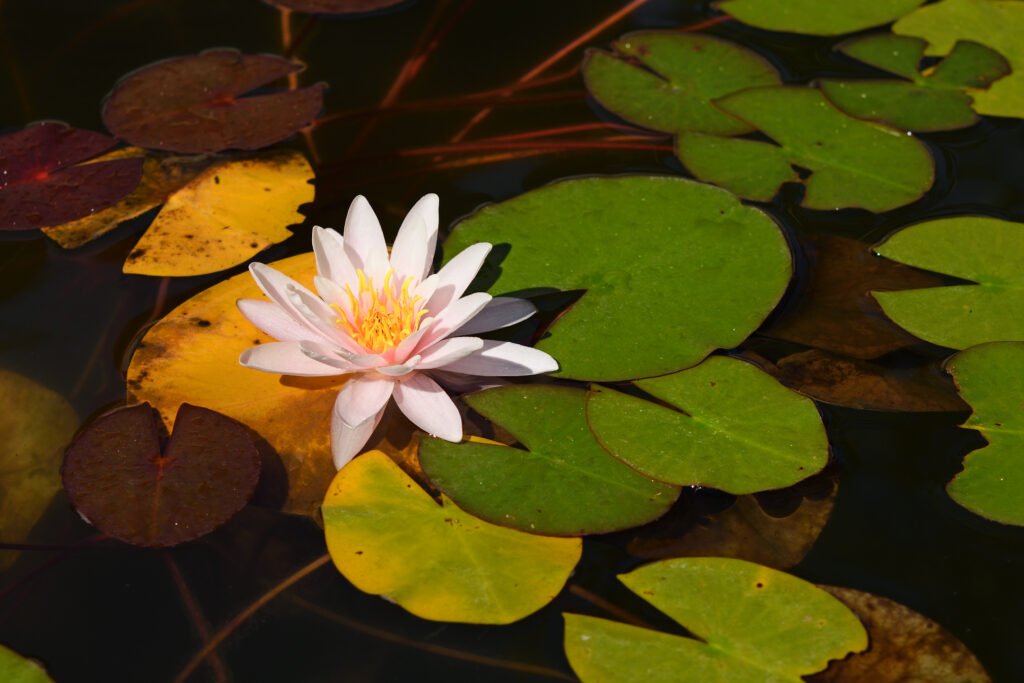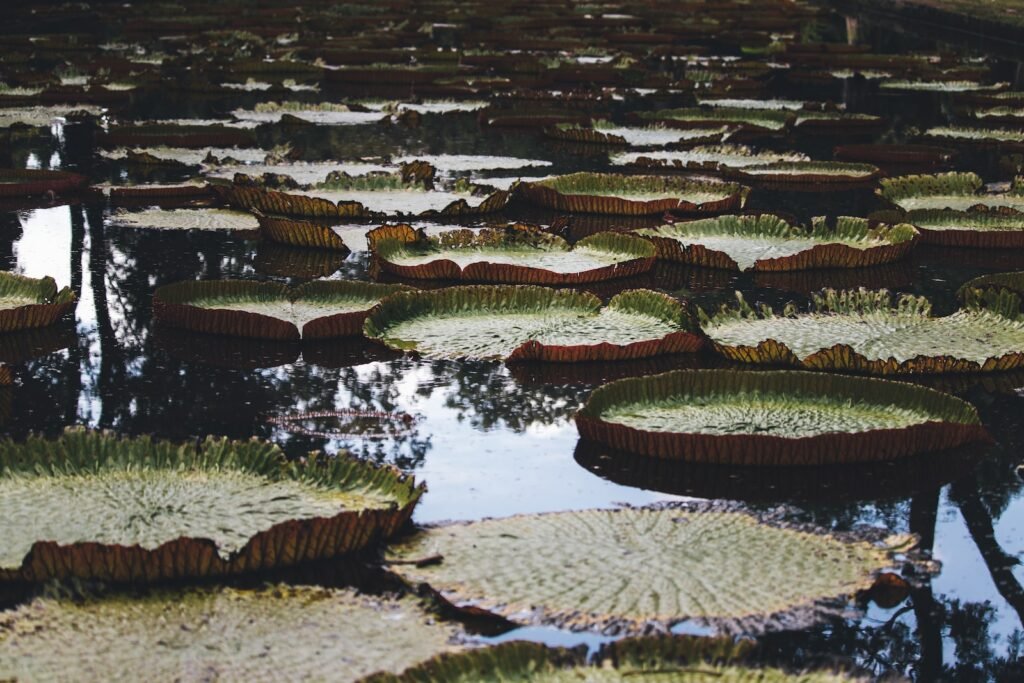Are you struggling with unwanted plants in your pond? If so, then don’t worry because we’ve got you covered.
Some of the links in this article may be affiliate links. If you make a purchase through these links, we may earn a small commission at no extra cost to you. Thank you.
In this article, we’ll show you how to effectively kill those pesky plants and reclaim your beautiful water feature.
With proper plant identification and the right herbicide, you’ll be able to target specific plants and prevent re-growth.
We’ll also guide you on safely applying herbicides and managing nutrient levels for long-term maintenance. Get ready to say goodbye to those unruly plants!
Proper Plant Identification
Proper plant identification is crucial to effectively killing plants in a pond.
Understanding the different types of aquatic plants and their characteristics will help you target them more efficiently. By correctly identifying the plants, you can choose the most appropriate method for removal or control.
You should also appreciate that knowing a bit about common plant diseases associated with aquatic plants can really help with re-growth prevention and plant treatment strategies.
Some common plant diseases include root rot, leaf spot, and fungal infections, which can negatively impact the health of your pond ecosystem if not addressed promptly.

On the other hand, it’s important to recognize that not all aquatic plants are harmful.
Many provide numerous benefits to your pond ecosystem and, for example, aquatic plants help regulate oxygen levels by producing oxygen through photosynthesis during the day and absorbing carbon dioxide at night. They also serve as habitat for fish and other aquatic organisms, providing shelter and protection.
Understanding proper plant identification is essential when dealing with unwanted vegetation in your pond while also appreciating the benefits that certain aquatic plants bring to maintaining a balanced and healthy ecosystem.
Choosing the Right Herbicide
To effectively control unwanted growth in your pond, you should consider selecting the right herbicide. The herbicide selection process is crucial for achieving the desired results without harming other aquatic life. There are various herbicide application techniques available, but choosing the most suitable one depends on factors such as plant species, size of the infestation, and water conditions. To help you make an informed decision, here is a table outlining different herbicides and their recommended uses:
| Herbicide | Recommended Use |
|---|---|
| Glyphosate | Broad-spectrum control of submerged and emergent plants |
| Diquat | Fast-acting treatment for floating and submerged weeds |
| Fluridone | Long-lasting control of persistent aquatic vegetation |
- COMPARE to Active Ingredient In Roundup Ultra
- NON-SELECTIVE, post emergent systemic herbicide
- PROVIDES broad-spectrum control of annual and perennial weeds, woody brush and trees.
- Visible effects within 2-4 days on most annual weeds and 7 or more days on most perennial weeds.
- Moves through the plant from the point of foliage contact to and into the root system.
Understanding Plant Growth Patterns
Understanding the different growth patterns of aquatic vegetation is essential in effectively managing and maintaining a healthy pond ecosystem. Here are some key points to consider:
- Different plants have different growth rates and habits, which can affect their overall impact on the pond.
- Some plants may grow rapidly and aggressively, overpowering other species and causing imbalances in the ecosystem.
- Factors such as water temperature, sunlight availability, nutrient levels, and pH can greatly influence plant growth.
- Plant growth inhibitors can be used to control excessive plant growth without harming the overall ecosystem.
How to Kill Specific Types of Plants in a Pond
Controlling aggressive plant growth in your pond can be achieved by targeting specific species.
One effective method is selective plant removal, which allows you to focus on the problematic plants without harming the beneficial ones. Identify the invasive species that are dominating your pond and causing an imbalance in its ecosystem.
These invasive plants tend to grow rapidly, outcompeting other native plants for nutrients and sunlight.
By removing them selectively, you can restore balance and promote healthier growth of desirable plants. Make sure to use proper techniques such as cutting or pulling out the targeted plants from their roots to prevent regrowth.
Regular monitoring and maintenance are crucial in controlling invasive species and maintaining a thriving pond environment.
Applying Herbicides Safely
When it comes to applying herbicides safely, there are a few key points to keep in mind. First and foremost, you want to ensure that you are using the right herbicide for the job and following the instructions carefully. This will not only help prevent environmental damage but also protect aquatic life in the area.
Safe Herbicide Application
To safely apply herbicide to kill plants in your pond, follow the instructions on the product label.
Start by identifying the target plants and selecting an appropriate herbicide. Read the label carefully to determine the correct application rate and timing.
It’s important to wear protective clothing, such as gloves and goggles, while applying herbicides.
For effective coverage, use a sprayer or a backpack sprayer with a nozzle that produces fine droplets. Make sure to evenly distribute the herbicide over the surface of the water where the plants are located. Avoid spraying on windy days or when rain is expected within 24 hours. If you prefer alternative methods, mechanical removal using rakes or cutting tools can be effective for smaller areas. However, keep in mind that manual removal may not completely eradicate all plant roots, allowing regrowth over time.
Preventing Environmental Damage
Using herbicides in a safe and responsible manner can help prevent harm to the environment. When it comes to promoting biodiversity and implementing sustainable aquatic management practices, it is crucial to consider the potential impacts of herbicide use. By following best practices, you can minimize environmental damage while effectively managing unwanted vegetation in your pond or water body.
To promote biodiversity, avoid using broad-spectrum herbicides that may harm non-target organisms. Instead, opt for selective herbicides that target specific plant species while preserving beneficial plants and aquatic life. Additionally, consider alternative methods such as manual removal or biological control to reduce reliance on chemicals.
Implementing sustainable aquatic management practices involves carefully considering the dosage and timing of herbicide applications. Applying herbicides during calm weather conditions and when there is minimal risk of drift will help prevent unintended damage to nearby ecosystems.
Preventing Plant Re-Growth
If you want to prevent plant re-growth in your pond, make sure to regularly remove any dead or decaying plant matter. This is important because preventing plant decay and controlling plant debris will help maintain a healthy ecosystem in your pond.
When plants die or start to decay, they release nutrients into the water that can fuel the growth of more plants. By removing this plant matter, you are reducing the available nutrients for new plant growth.

Additionally, decaying plants can create an unsightly mess and potentially clog up filters or pumps in your pond.
So, take some time each week to skim off any floating debris and use a net or rake to remove any larger pieces of dead vegetation from the bottom of your pond. This simple maintenance routine will go a long way in preventing unwanted plant re-growth and keeping your pond looking beautiful.
Managing Nutrient Levels
Regularly removing dead or decaying plant matter helps to control nutrient levels in your pond and maintain a healthy ecosystem.
The nutrient balance in your pond is crucial for the overall health of the plants and animals that call it home. When there is an excess of nutrients, such as nitrogen and phosphorus, it can lead to algae blooms and other water quality issues.
On the other hand, a nutrient deficiency can cause stunted plant growth and poor water clarity. By removing dead or decaying plant matter, you are reducing the amount of organic material that decomposes in your pond, which in turn helps to regulate nutrient levels.
This simple maintenance task plays a vital role in keeping your pond’s nutrient balance in check and preventing potential problems down the line.
Monitoring and Maintenance
Monitoring and maintenance are essential for ensuring the health and balance of your pond’s ecosystem. By regularly observing and caring for your pond, you can prevent potential issues from escalating into major problems. Here are four maintenance techniques to help you keep your pond in optimal condition:
Regularly test water quality: Use a testing kit to monitor pH levels, ammonia, nitrate, and phosphate concentrations. This will help you identify any imbalances that could harm your pond’s inhabitants.
Clean debris: Remove fallen leaves, twigs, and other organic matter that can accumulate on the surface or sink to the bottom of the pond. Excess debris can lead to poor water quality and provide nutrients for unwanted plant growth.
Control algae growth: Algae blooms can disrupt the balance of your pond’s ecosystem. Implement strategies like adding aquatic plants or using UV clarifiers to control algae growth.
Address fish health concerns: Keep an eye out for signs of illness or stress in your fish population. Monitor their behavior, appetite, and physical appearance to catch any issues early on.
Frequently Asked Questions
How Can I Prevent the Growth of Algae in My Pond?
To prevent algae growth in your pond, try natural alternatives instead of pond herbicides. Regularly clean and remove debris, limit sunlight exposure with shade or plants, and consider using barley straw.
Are There Any Natural Alternatives to Herbicides That Can Effectively Kill Plants in a Pond?
Natural alternatives, such as manual removal, can effectively kill plants in a pond without the use of herbicides. They provide a safer and more environmentally friendly option for controlling plant growth in your pond.
How Often Should I Monitor and Maintain My Pond to Ensure Effective Plant Control?
To ensure effective plant control in your pond, you should monitor it regularly and perform maintenance techniques accordingly. By keeping a close eye on the pond’s condition, you can address any issues promptly and maintain a healthy balance.
Can I Use Herbicides to Kill Plants in My Pond During the Winter Season?
Yes, you can use herbicides to kill plants in your pond during the winter season. They are effective for winter plant control and can help maintain a healthy balance in your pond ecosystem.
What Should I Do if I Accidentally Apply Too Much Herbicide in My Pond?
If you accidentally apply too much herbicide in your pond, don’t panic. Dilute the water with fresh water and remove any dead plants. Consider using alternative plant control methods like manual removal or biological controls.
Conclusion
In conclusion, successfully killing plants in a pond requires careful planning and execution. By properly identifying the plants and selecting the appropriate herbicide, you can effectively target specific species. It is important to understand plant growth patterns and apply herbicides safely to avoid harming other organisms in the pond. Additionally, preventing plant re-growth and managing nutrient levels are key factors in maintaining a healthy pond ecosystem. Regular monitoring and maintenance will ensure long-term success in keeping unwanted plants at bay.


